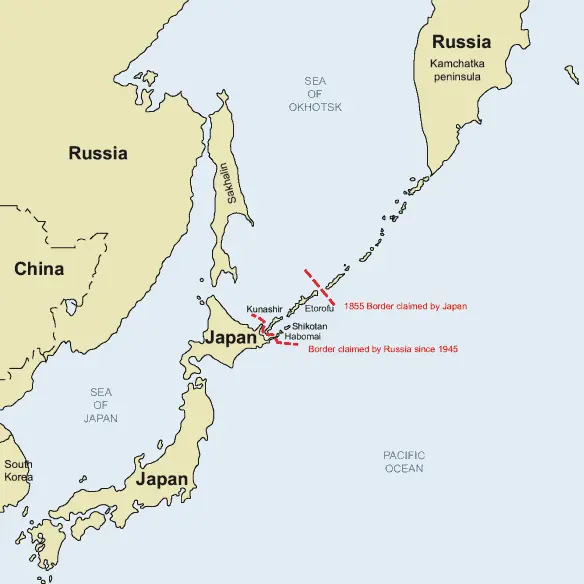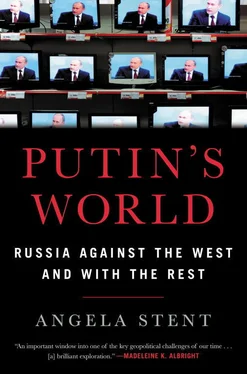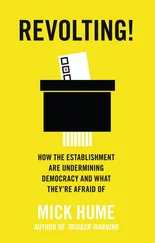On the eve of the February 1945 Yalta Conference, President Roosevelt was given a State Department briefing paper emphasizing that these four islands were acquired legally by Japan and belonged to Japan—but he apparently failed to read the paper. 16By the terms of the Yalta agreement, the USSR was to enter the war against Japan three months after the end of the war in Europe. The secret amendment to the Yalta treaty states: “The Kuril islands shall be handed over to the Soviet Union.” 17By the time the USSR took the four Kuril Islands—the Habomais, Shikotan, Kunashir, and Etorofu—Japan was a defeated nation, and the Soviet Union’s allies, the United States and Britain, did not object. In his September 1945 Victory Speech, Stalin declared that the islands would serve “as a direct means of communication between the Soviet Union and the ocean and a base for the defense of our country against Japanese aggression.” 18The four islands were strategically located on the outer edge of the Sea of Okhotsk, providing access for the Soviet Pacific Fleet to the Pacific Ocean, and they also were an economic prize, with a significant fish population.

When the USSR abrogated its neutrality pact with Japan and commenced its offensive against the crumbling Japanese army in Manchuria, it captured 640,000 Japanese soldiers. These prisoners of war were subject to forced labor to construct the Baikal-Amur Railroad, and 62,000 of them perished. The surviving POWs returned to Japan in 1956, when diplomatic relations between the two countries were restored. 19
In 1956, after difficult negotiations, the USSR and Japan signed a joint declaration whereby the USSR agreed to “transfer” to Japan the two smaller islands—Shikotan and the Habomais. 20However, this would occur only after the conclusion of a peace treaty between the two countries. 21Indeed, the Soviets were preparing to hand back the two islands, but the Japanese side would not compromise and insisted that all four islands be returned. Subsequently, the Soviets hardened their position, saying they would not transfer the islands until all foreign (i.e., American) troops were withdrawn from Japan. But the 1956 agreement remains the only deal on the table. Putin has regularly said that Russia is prepared to negotiate with Japan on the basis of this agreement, but the Japanese constitution explicitly ties the conclusion of a peace treaty to the return of all four islands. Moreover, the two islands the Russians have offered are much smaller than the two Moscow would have retained. So, more than seven decades after the end of World War Two, Russia and Japan have not signed a peace treaty because of a dispute over four small but strategically located islands.
THE GORBACHEV NON-BREAKTHROUGH
When in the 1980s Mikhail Gorbachev proclaimed a need for New Political Thinking, it appeared to open the door for progress in the stalled Russia-Japan relationship. In his memoirs, he wrote: “It was very important to me that relations with this large neighbor be normalized and improved.” Gorbachev made a major speech in the summer of 1986 in Vladivostok calling for a recalibration and improvement of the USSR’s ties with Asia, particularly China. But according to the Soviet leader, Japan displayed a “cool and suspicious reaction” to his speech. 22The Japanese Ministry of Foreign Affairs was initially reluctant to respond to Soviet overtures. Moreover, Gorbachev had to postpone his planned visit to Japan several times because of the tumultuous international situation he faced as the Soviet bloc began to crumble. Perhaps if he had gone to Tokyo in 1989—as originally planned—he would have been in a stronger position domestically to make compromises. But a variety of domestic pressures, especially the rise of his archrival, Boris Yeltsin, made this very difficult.
Gorbachev’s long-awaited visit—the first to Japan by any Soviet or Russian leader—was an anticlimax. 23It came in April 1991, three months before the coup by inept hard-line plotters that nearly ousted him. By this time Gorbachev was facing mounting pressure from both right-and left-wing opponents. In an important gesture of reconciliation, Gorbachev stopped in Khabarovsk on his way to Tokyo and laid a wreath at the graves of Japanese POWs. He also handed over to the Japanese government a list of the dead. When he and his wife, Raisa, arrived, they were whisked away from the airport to meet the emperor, but their route was changed to avoid the thousands of right-wing demonstrators protesting his visit and demanding the return of the islands.
On the face of it, an economic-political deal might have been possible. The USSR’s economic situation was deteriorating, with declining growth rates and an economy hit hard by the 1986 collapse in oil prices. Japan could have been a significant source of investment and trade, in return for a possible political compromise from the Soviet side. But economic incentives were apparently insufficient to overcome the Kremlin’s resistance to a territorial deal. Little progress was made on the island question. Gorbachev argued with his Japanese interlocutors about who was responsible for the “illegal” seizure of islands. Nor did Gorbachev come away with any major new economic cooperation projects, although this was one of his key goals. He failed to close the deal he sought: guarantees for private investment in the Soviet Union and official loans. In the final joint communiqué between the two countries, the Soviet side for the first time acknowledged that a territorial dispute existed, the islands were named, and both sides agreed to work together to establish a visa-free regime for visits by Japanese to the four islands. 24Gorbachev also promised to reduce the Soviet military presence on the islands. But beyond that, little concrete was accomplished.
THE YELTSIN “NO NECKTIE” SUMMITS
After Yeltsin replaced Gorbachev, a familiar pattern in Russo-Japanese relations emerged. Each new Russian or Japanese leader would come into office determined to find a more productive way to normalize relations, and there would be an initial period of raised expectations, followed by disappointment and mutual recriminations. After Russia joined the G-8 group of advanced industrialized countries in 1997, for the first time it had Japan as a partner in this kind of organization—until Russia was thrown out in 2014 following the annexation of Crimea. The Japanese side insisted on linking the political and economic aspects of bilateral relations, whereas the Russians tried to separate them. A vicious circle developed, whereby Russia’s reluctance to discuss territorial issues prevented Japan from offering economic assistance to Russia’s struggling economy, and that in turn strengthened nationalistic forces in Russia that opposed territorial concessions. 25
Yeltsin had announced that he would visit Japan in 1992, hinting that a territorial deal might be in the cards. But four days before his planned trip, Yeltsin abruptly telephoned Prime Minister Kiichi Miyazawa and called off his trip, leaving the Japanese reeling from a “big shock.” 26Why did Yeltsin get cold feet? The ostensible reason was safety concerns. Yeltsin cited “domestic circumstances” in Russia, Japan’s rigidity over the Kuril question, and Japan’s inability to ensure the Russian president’s safety in the face of extremist demonstrators in Japan. 27Yeltsin’s Security Council reportedly overrode his decision to make the trip, although he took sole responsibility for the cancellation. The Japanese government was furious, and anti-Russian sentiment was on the rise.
But Yeltsin persisted and eventually made it to Tokyo in October 1993, shortly after he had eliminated a major source of domestic opposition by firing on the Russian parliament—whose members had vowed armed resistance to his policies. Yeltsin announced his intention to visit Tokyo a few weeks after the assault on the parliament, and its timing suggests he wanted to demonstrate that he was once again in full command after prevailing over his opponents who had threatened violence. As it turned out, violence awaited him in Tokyo. The protests began before he arrived: black trucks with mounted loudspeakers drove through Tokyo’s streets, shouting anti-Yeltsin diatribes and demanding the return of the Northern Territories, and smoke bombs were tossed into the Russian embassy compound. Ten thousand riot-geared officers surrounded the Russian embassy as Yeltsin arrived. 28
Читать дальше













